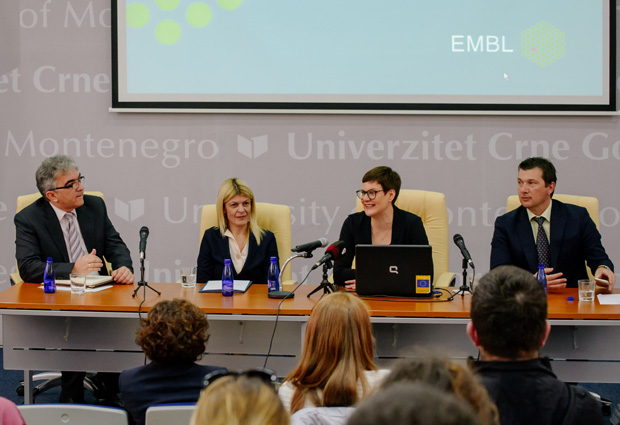
Read the latest Issue
Montenegro’s Minister of Science discusses the importance of international collaboration in research

Montenegro submitted a formal application to become an EMBL member state in November 2017, and the country is currently completing its parliamentary ratification procedure. This month, EMBL’s Director of International Relations, Silke Schumacher, met with representatives of research institutes and academia in the country’s capital, Podgorica, to discuss the benefits of EMBL membership and to explore opportunities for collaboration.
We took this opportunity to speak to Montenegro’s Minister of Science, Sanja Damjanović, about the value of collaborative research.
We first contacted EMBL in January last year to discuss the possibility of forming collaborations between Montenegrin scientists and those at EMBL. Montenegro has never been a member of any international research institutions, so when I was appointed as Minister of Science my first aim was to improve that situation. I made contact with CERN and EMBL to find out if we can become a member of these two renowned institutions.
Montenegro is a small country with a population of about 640,000. Relative to population, the number of scientists we have is similar to other countries, but the actual numbers are small – around 1800 researchers and 850 PhD students. Our previous Minister of Science made a lot of progress in connecting Montenegro to EU programmes like Horizon 2020, but our success rate for securing funding in this programme has been low. We really need to be part of a bigger network to be competitive. Joining EMBL and forming collaborations with EMBL scientists will help us to do that. It will also enrich life science research in our country and give us excellent opportunities to train our young people.

I’ve taken a leading role in a new initiative which was proposed by Professor Herwig Schopper – a former director general of CERN. His idea was to establish a new international institute in South East Europe (SEE), which would transform science, technology, and the economy in that region. A major issue in the region is brain drain, and I’m convinced that establishing an international institute here will help to reduce this problem or even reverse it.
For me, it’s a pleasure to work with Professor Schopper and benefit from his experience – he’s 93 and full of energy. As a former Chairman of the Directorate of DESY, he was involved in setting up EMBL’s second site in Hamburg, as part of an agreement with EMBL’s first Director General, John Kendrew. He was also a founding father of the SESAME project in Jordan, bringing together nine countries in the Middle East.
At present, ten countries are interested in taking part in the SEE project. At CERN in October 2017 we signed a declaration of intent to establish an international scientific institute. We’re now building support, and the goal is that the project should be financed mostly from EU funds. I think we need to work hard but there is a great chance to realise this project.
In January there was a Forum on New International Research Facilities in South East Europe, held in Trieste, where concept designs for the SEE project were presented for the first time, both to the political and scientific communities. It turned out to be a really great event, attracting more than 100 participants, including high-level representatives from the European Commission, the European Strategy Forum on Research Infrastructures, various scientific organisations, and representatives of the scientific and business communities in the region.
An intergovernmental steering committee for the SEE project has also been formed and I’ve been elected as Chairperson. In its recent meeting in Tirana, Albania, the committee unanimously agreed to establish as the core of the SEE project a regional institute for tumour therapy and biomedical research using protons and heavy ions.
I was a scientist for nearly two decades. For most of that time I was working in two international organisations: CERN in Geneva, Switzerland, and the GSI Helmholtz Centre for Heavy Ion Research in Darmstadt, Germany. I worked both on fundamental and applied research in the field of high-energy nuclear physics. On the fundamental side I focused on studies of quark-gluon plasma – a state of matter which is created in high-energy nuclear collisions and closely resembles matter in the early universe, just a few microseconds after the Big Bang. My applied research focused on ways to protect both machinery and personnel from the high radiation levels in these experiments.
I don’t really know how! That offer came as a surprise because I’d been working outside Montenegro for twenty years. I think the new government wanted to set progress in science as a high priority, so one advantage I had is being connected already with people in these international organisations. In a way, being a scientist and being Minister of Science is not so different – in both cases you find that 24 hours per day is too few! There’s not much time for anything else.
Looking for past print editions of EMBLetc.? Browse our archive, going back 20 years.
EMBLetc. archive